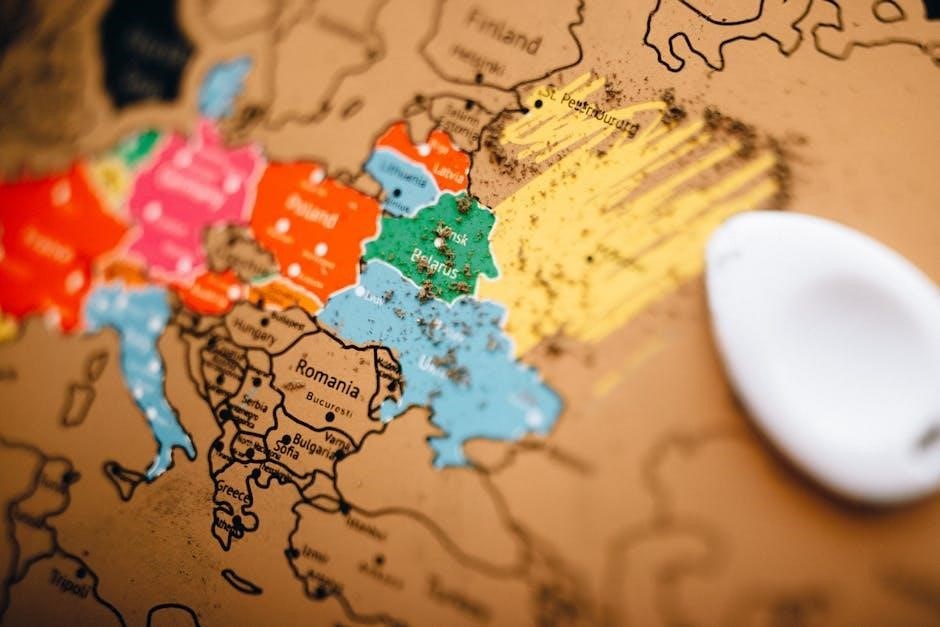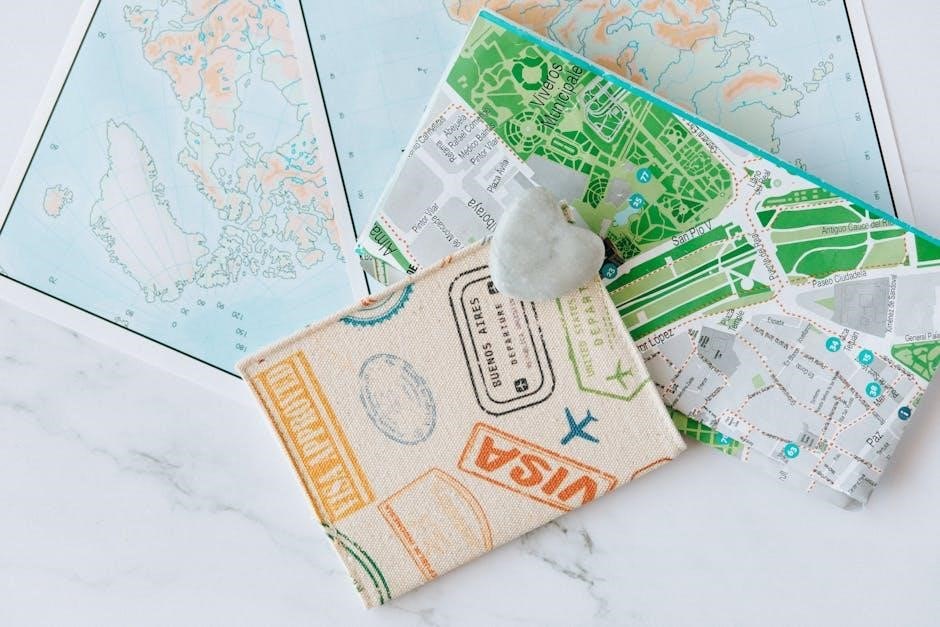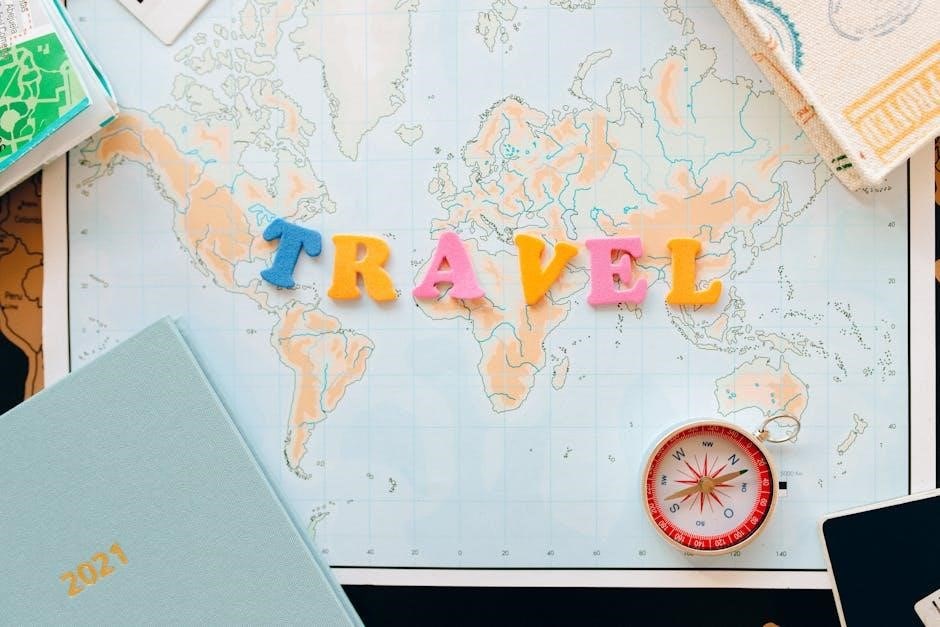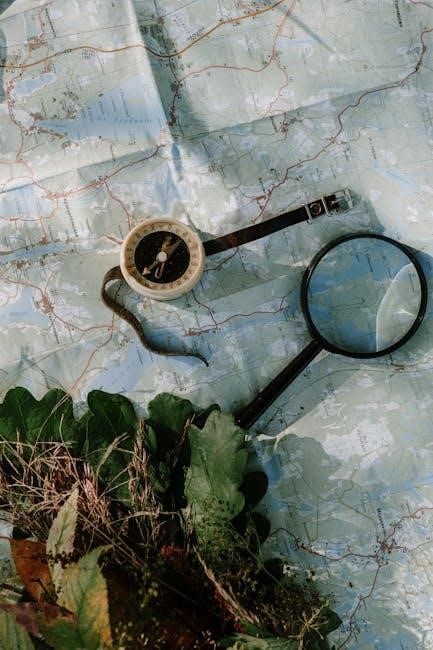
how to use the map guide lwmfmaps.
Start by examining the map’s compass rose to determine orientation. Circle key landmarks and roads‚ focusing on connectors for navigation. Use the scale to measure distances accurately. Identify symbols and legends to understand map elements. This guide helps you explore areas efficiently‚ whether for travel or research purposes.
Plot routes by marking start and end points‚ then plan itineraries. Customize the map by highlighting areas of interest. Integrate with GPS tools for real-time navigation. Understand map projections to interpret spatial data accurately. This comprehensive approach ensures effective use of the LWMFMAPS guide for any situation.

Welcome to the LWMFMAPS guide‚ your essential tool for navigating and understanding maps with precision. Designed to enhance your mapping experience‚ LWMFMAPS offers a comprehensive approach to exploring territories‚ whether for travel‚ research‚ or everyday use. This guide is tailored to help you unlock the full potential of maps‚ providing clear instructions and practical tips.
Maps are more than just visual representations of landscapes; they are keys to discovering new places‚ planning routes‚ and analyzing spatial data. LWMFMAPS equips you with the skills to interpret map symbols‚ use scales for distance measurement‚ and identify landmarks. It also emphasizes the importance of compass directions for accurate navigation.
By focusing on simplicity and clarity‚ LWMFMAPS ensures that both beginners and experienced users can benefit. This guide encourages you to customize maps according to your needs‚ explore detailed tiles for in-depth analysis‚ and integrate digital tools like GPS for seamless navigation. Start your journey with LWMFMAPS and transform the way you interact with maps.
Understanding the Basic Elements of a Map
Every map is composed of essential elements that help users interpret and navigate its contents effectively. The title provides the name and context of the map‚ while the legend explains the meaning of symbols and colors. The scale allows users to measure distances proportionally‚ ensuring accurate calculations. A compass rose indicates directions‚ helping to orient the map correctly.
Maps also feature a grid system‚ with lines and coordinates to pinpoint locations. The frame or border defines the map’s boundaries‚ and the source or credit line acknowledges the creator and data sources. Understanding these elements is fundamental for effective map reading. For instance‚ scientists use maps to study environmental changes over time‚ while historians analyze them to understand past perceptions of the world.
By focusing on these basic components‚ users can unlock the full potential of maps for navigation‚ research‚ or planning. Whether exploring local areas or analyzing global datasets‚ mastering these elements ensures a clearer understanding of spatial information. This foundation is crucial for more advanced techniques‚ such as plotting routes or integrating digital tools.

How to Read Map Symbols and Legends
Understanding map symbols and legends is crucial for interpreting the information presented. The legend serves as a key‚ explaining the meaning of various symbols‚ colors‚ and markings. It helps users identify features like roads‚ buildings‚ water bodies‚ and vegetation. Start by locating the legend‚ usually found in a corner of the map‚ and familiarize yourself with its contents.
Symbols are standardized to ensure consistency across maps. For example‚ a blue line typically represents a river‚ while a black dot might indicate a city. Colors also play a significant role‚ with different hues distinguishing between land types or elevations. Practice associating symbols with their meanings to enhance your map-reading skills.
Pay attention to special symbols that highlight points of interest‚ such as landmarks or historical sites. By mastering the legend‚ you can decode the map’s language and navigate effectively. This skill is especially useful for travelers‚ hikers‚ and researchers relying on maps for accurate spatial information. Regular practice will make interpreting symbols second nature‚ improving your overall mapping experience.
Using the Scale to Measure Distances
The scale is a fundamental tool for measuring distances on a map. Located at the bottom or side‚ it converts map distances into real-world units like kilometers or miles. To use it‚ align a ruler with the scale and measure the distance between two points. Ensure the units match the scale’s markings for accuracy.
Most maps use a bar scale with markings representing equal distances. For example‚ each line might signify 1 km or 1 mile. Some scales include multiple units for international compatibility. Practice by measuring known distances‚ such as the length of a road or the distance between landmarks.
Digital tools can simplify measurements‚ but manual methods remain reliable; When scaling‚ consider the map’s projection‚ as distortions may affect accuracy. Always cross-reference with the legend and other map elements for context. This skill is indispensable for planning routes and estimating travel times.
By mastering the scale‚ you can transform abstract map representations into actionable data‚ enhancing your navigation and exploration capabilities. Regular practice will make measuring distances intuitive‚ whether for hiking‚ urban navigation‚ or scientific research.
Identifying Key Landmarks and Points of Interest
Key landmarks and points of interest are essential for effective navigation using the LWMFMAPS guide. These features‚ such as rivers‚ mountains‚ parks‚ and major highways‚ are often highlighted with distinct symbols or colors. Start by locating prominent natural and man-made structures‚ as they serve as reference points for orientation.
Use the map’s legend to identify the symbols representing landmarks like hospitals‚ airports‚ or historical sites. Circle or underline these points to make them stand out. For urban areas‚ focus on central squares‚ train stations‚ or famous buildings. In natural environments‚ note rivers‚ lakes‚ or mountain peaks.
Practice by identifying how landmarks connect to each other. For example‚ a river might flow through a city‚ linking parks and industrial areas. This helps build a mental map of the region. Use compass directions to describe the relative positions of landmarks‚ aiding in navigation.
Integrate this skill with digital tools like Google My Maps to mark and customize your own points of interest. By mastering the identification of landmarks‚ you can enhance your ability to explore and navigate effectively‚ whether in unfamiliar cities or remote landscapes.

Navigating with Compass Directions
Navigating with compass directions is a fundamental skill when using the LWMFMAPS guide. Most maps feature a compass rose‚ typically located in a corner‚ which indicates north‚ south‚ east‚ and west. Align the compass rose with your actual compass to maintain proper orientation. This ensures that directions on the map align with real-world directions.
Use cardinal directions (north‚ south‚ east‚ west) and intercardinal directions (northeast‚ southwest‚ etc.) to describe locations. For example‚ “The park is located northeast of the city center.” This helps in pinpointing positions accurately. Additionally‚ use relative directions like “left‚” “right‚” “ahead‚” or “behind” when moving around the map.
When navigating‚ always consider the map’s orientation. If you rotate the map‚ adjust your compass directions accordingly. Practice by identifying landmarks relative to each other using compass terms. For instance‚ “The river flows northwest into the lake.” This skill is especially useful in wilderness areas or unfamiliar territories.
Combine compass directions with grid lines or latitude and longitude for precise location identification. By mastering this technique‚ you can confidently navigate using the LWMFMAPS guide‚ whether in urban environments or remote landscapes.
Plotting Routes and Planning Itineraries
Plotting routes and planning itineraries with the LWMFMAPS guide involves identifying start and end points and marking the most efficient paths. Begin by circling key destinations on the map‚ such as landmarks‚ waypoints‚ or important locations. Use a pen or digital tool to draw lines connecting these points‚ ensuring the route follows roads‚ trails‚ or other navigable features.
Measure distances using the scale to estimate travel time and effort. Consider potential obstacles‚ such as rivers or mountains‚ and plan detours if necessary. For detailed planning‚ divide the route into segments‚ noting rest stops‚ fuel stations‚ or other essential points. Use symbols or colors to categorize activities‚ such as accommodations‚ dining‚ or sightseeing.

Customize the itinerary by annotating the map with notes‚ timestamps‚ or priorities. This helps in organizing the journey and ensuring all key stops are included. For digital users‚ integrate GPS data to track progress in real time. By plotting routes and planning itineraries‚ you can create a clear‚ organized path for any adventure‚ whether exploring a new city or embarking on a wilderness trek.

Regularly review and adjust the plan to accommodate changes in weather‚ road closures‚ or unexpected discoveries. This flexible approach ensures a smooth and enjoyable experience while using the LWMFMAPS guide.
Using Map Tiles for Detailed Exploration
Map tiles are a powerful tool for detailed exploration‚ allowing users to focus on specific regions within a larger map. By dividing the map into manageable sections‚ tiles provide a zoomed-in view of areas of interest. To use map tiles effectively‚ start by identifying the region you wish to explore and locate the corresponding tile.
Use the scale and grid system to measure distances and pinpoint exact locations. Tiles often feature detailed annotations‚ such as road names‚ trail markers‚ or points of interest. These elements help in navigating complex areas with precision. For digital maps‚ tiles can be downloaded for offline use‚ ensuring access even without internet connectivity.
Tiles also enable layering‚ where additional information like terrain‚ vegetation‚ or historical data can be overlaid. This feature is particularly useful for scientific or historical analysis. By examining multiple tiles side by side‚ users can piece together a broader understanding of the landscape.
Organizing tiles in a grid or atlas format allows for seamless transitions between sections. This method is ideal for planning long-distance journeys or studying large-scale geographical features. Map tiles enhance exploration by providing a detailed‚ focused view of the world‚ making them indispensable for both casual users and professionals.
Customizing Your Map for Specific Needs
Customizing your map is essential for tailoring it to your specific requirements. Start by identifying the purpose of your map‚ whether it’s for travel‚ research‚ or personal use. Use the legend to understand symbols and adjust the visual elements to highlight what matters most.

Add annotations or markers to key locations‚ such as landmarks or points of interest. For digital maps‚ utilize tools like Google My Maps or ArcGIS to overlay custom layers‚ such as routes‚ boundaries‚ or data points. This feature is particularly useful for historical or scientific analysis.

Experiment with different map projections to better suit your needs‚ ensuring accuracy in representation. Adjust the scale to focus on specific areas or broaden the view for context. Incorporate additional information like compass directions or grid systems for enhanced navigation.
For physical maps‚ use color-coding or stickers to categorize locations. This helps in quickly identifying patterns or priorities. Save multiple versions of your customized map for different scenarios‚ ensuring flexibility in various situations. By personalizing your map‚ you create a tool that aligns perfectly with your goals and preferences.
Integrating Maps with GPS and Digital Tools
Integrating maps with GPS and digital tools enhances navigation and planning. Start by syncing your map with a GPS device or smartphone app‚ ensuring real-time tracking. Use software like ArcGIS or Google Maps to overlay digital data onto your map‚ providing precise location markers and directions.
Digital tools allow you to import maps into applications‚ enabling features like route calculation and geolocation. For example‚ Google My Maps lets you create custom layers and share locations. GPS devices can also import map data‚ providing turn-by-turn directions and waypoints.
Ensure compatibility by converting maps to formats like KML or GPX for use in GPS systems. Regularly update your digital tools to access the latest map data and features. This integration bridges traditional cartography with modern technology‚ offering unparalleled convenience and accuracy for explorers and planners alike.
By combining physical maps with digital tools‚ you gain a comprehensive navigation system tailored to your needs. This approach is ideal for adventurers‚ researchers‚ and anyone seeking precise spatial information in the field or office.
Understanding Map Projections and Limitations
Map projections are methods of representing the Earth’s surface on a flat plane‚ each with unique distortions. Common projections include Mercator‚ Gall-Peters‚ and Robinson‚ prioritizing shape‚ size‚ or distance accuracy. Understanding these helps interpret spatial data effectively.
Projections inherently distort features like size‚ shape‚ or distance. For example‚ the Mercator projection distorts areas far from the equator‚ making regions like Greenland appear larger than Africa. This limitation is crucial for accurate analysis‚ especially in scientific or historical studies.
The Gall-Peters projection reduces size distortions but may compromise shape accuracy‚ offering a more equitable representation of regions. Other projections balance these factors‚ highlighting the need to choose the right one for specific purposes.
- Be aware of projection limitations when analyzing global data.
- Choose projections that align with your mapping goals.
- Consult multiple projections for a comprehensive understanding.
Recognizing these constraints ensures more accurate and informed decision-making when using maps for research‚ navigation‚ or education.
Applying Maps for Historical and Scientific Analysis
Maps are invaluable tools for historical and scientific research‚ offering insights into how our planet has evolved. By comparing maps over time‚ scientists can study environmental changes‚ such as deforestation or glacier retreat. Historians use maps to understand historical perspectives‚ borders‚ and cultural perceptions of Earth.
Tools like ArcGIS StoryMaps enable researchers to create interactive narratives‚ combining maps with data to explore historical events or scientific phenomena. For example‚ maps can illustrate the migration of species‚ the spread of diseases‚ or the impact of climate change over decades.
In scientific analysis‚ maps help visualize data‚ such as population density or resource distribution. They also aid in tracking changes in ecosystems or urban growth. For historians‚ maps reveal past geopolitical boundaries‚ trade routes‚ and settlements‚ providing context for historical events.
- Use historical maps to trace the evolution of regions and cultures.
- Apply scientific mapping tools to analyze environmental and demographic trends.
- Combine maps with other data sources for comprehensive research.
By integrating maps into historical and scientific studies‚ researchers can uncover patterns and connections that might otherwise remain hidden‚ enhancing our understanding of the world.

Tips for Creating Your Own Map Guides
Creating your own map guide can be a rewarding project‚ whether for personal use‚ education‚ or sharing with others. Start by identifying the purpose of your map to ensure it meets specific needs. Use a base map and add layers of information‚ such as landmarks‚ roads‚ or points of interest‚ to enhance clarity.
Customize your map by highlighting important features and using symbols that are easy to understand. Consider the scale and ensure it is appropriate for the level of detail you want to convey. For digital maps‚ tools like Google My Maps or ArcGIS StoryMaps can help you create interactive and shareable guides.

- Keep the design simple and avoid clutter to maintain readability.
- Incorporate a legend or key to explain symbols and abbreviations.
- Use high-quality images or screenshots if adding visual elements.
- Test your map with others to gather feedback and improve usability.
For historical or scientific maps‚ include timelines or data overlays to provide context. Regularly update your map guide to reflect changes in the environment or new discoveries. By following these tips‚ you can create a map guide that is both functional and engaging for its intended audience.
Mastering the use of the LWMFMAPS guide is a valuable skill that enhances navigation‚ exploration‚ and planning. Always start by understanding the map’s orientation and scale‚ as these are foundational for accurate interpretation. Regularly practice reading symbols‚ legends‚ and compass directions to build confidence in navigating unfamiliar territories.
When creating your own map guides‚ keep designs simple and focused on the intended purpose. Use tools like Google My Maps or ArcGIS for interactive features. Test your maps with others to ensure clarity and usability. For best results‚ update your maps periodically to reflect changes in the environment or new discoveries.
Integrate maps with GPS and digital tools for real-time navigation‚ especially in remote areas. Remember that maps are not just for travel—they can also be powerful tools for historical and scientific analysis. By following these best practices‚ you can maximize the effectiveness of your map guide and enjoy a seamless experience in exploring the world around you.